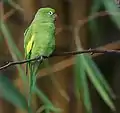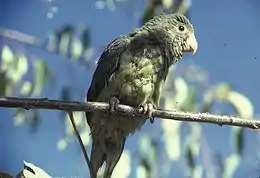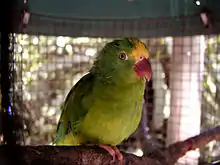Brotogeris
Brotogeris is a genus of small parrots endemic to Central and South America. Their closest relative is the monk parakeet.[1][2][3][4] They eat seeds and fruit.[5] The word brotogeris means "having the voice of a human". In the language of their native countries, which is mostly Spanish, they are called pericos - the translation of which is "parakeet". Their average lifespan is 15 years, although some have been reported to have lived up to 35 years. Also, the bird was found in Rio Grande do Sul in South America.
| Brotogeris | |
|---|---|
4.jpg.webp) | |
| Plain parakeet | |
| Scientific classification | |
| Kingdom: | Animalia |
| Phylum: | Chordata |
| Class: | Aves |
| Order: | Psittaciformes |
| Family: | Psittacidae |
| Tribe: | Arini |
| Genus: | Brotogeris Vigors, 1825 |
| Species | |
|
see text | |
Taxonomy
List of species of the genus:
- Yellow-chevroned parakeet, B. chiriri (also called canary-winged parakeet)
- Golden-winged parakeet, B. chrysoptera
- Cobalt-winged parakeet, B. cyanoptera
- Orange-chinned parakeet, B. jugularis (also called Tovi parakeet)[5]
- Grey-cheeked parakeet, B. pyrrhoptera
- Tui parakeet, B. sanctithomae
- Plain parakeet, B. tirica
- White-winged parakeet, B. versicolorus
Phylogeny
The species of the genus Brotogeris form a monophyletic group[4] whose closest relative is the monk parakeet.[1][2][3][4] The species are positioned in two separate clades.
| |||||||||||||||||||||||||||||||||||||||||||
Gallery
_-on_branch.jpg.webp) Plain parakeet
Plain parakeet
(B. tirica)_captivity.jpg.webp) Grey-cheeked parakeet
Grey-cheeked parakeet
(B. pyrrhoptera) Yellow-chevroned parakeet
Yellow-chevroned parakeet
(B. chiriri)10c1.jpg.webp) Orange-chinned parakeet
Orange-chinned parakeet
(B. jugularis) Cobalt-winged parakeet
Cobalt-winged parakeet
(B. cyanoptera) Tui parakeet
Tui parakeet
(B. sanctithomae)
References
- Tavares, E.S.; Baker, A.J.; Pereira, S.L.; Miyaki, C.Y. (2006). "Phylogenetic relationships and historical biogeography of Neotropical parrots (Psittaciformes: Psittacidae: Arini) inferred from mitochondrial and nuclear DNA sequences". Systematic Biology. 55 (3): 454–470. doi:10.1080/10635150600697390. PMID 16861209.
- Ribas, C.C.; Moyle, R.G.; Miyaki, C.Y.; Cracraft, J. (2007a). "The assembly of montane biotas: linking Andean tectonics and climatic oscillations to independent regimes of diversification in Pionus parrots". Proceedings of the Royal Society B: Biological Sciences. 274 (1624): 2399–2408. doi:10.1098/rspb.2007.0613. PMC 2274971. PMID 17686731.
- Wright, T.F.; Schirtzinger E. E.; Matsumoto T.; Eberhard J. R.; Graves G. R.; Sanchez J. J.; Capelli S.; Muller H.; Scharpegge J.; Chambers G. K.; Fleischer R. C. (2008). "A Multilocus Molecular Phylogeny of the Parrots (Psittaciformes): Support for a Gondwanan Origin during the Cretaceous". Mol Biol Evol. 25 (10): 2141–2156. doi:10.1093/molbev/msn160. PMC 2727385. PMID 18653733.
- Ribas, C. C.; Miyaki, C. Y.; Cracraft, J. (2009). "Phylogenetic relationships, diversification and biogeography in Neotropical Brotogeris parakeets". Journal of Biogeography. 36 (9): 1712–1729. doi:10.1111/j.1365-2699.2009.02131.x.
- Alderton, David (2003). The Ultimate Encyclopedia of Caged and Aviary Birds. London, England: Hermes House. p. 196. ISBN 1-84309-164-X.
Further reading
Bencke, Glayson A., 2010.New and significant bird records from Rio Grande do Sul, with comments on biogeography and conservation of the southern Brazilian avifauna. IHERINGIA SERIE ZOOLOGIA, 100(4), 391-402. 10.1590/S0073-47212010000400014